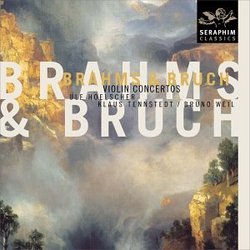| All Artists: Brahms, Bruch, Hoelscher, Weil Title: Violin Cto in D / Violin Cto 1 in G Minor Sym 3 Members Wishing: 0 Total Copies: 1 Label: Angel Records Release Date: 1/25/2000 Genre: Classical Styles: Forms & Genres, Concertos, Instruments, Strings, Symphonies Number of Discs: 1 SwapaCD Credits: 1 UPC: 724357370325 |
Search - Brahms, Bruch, Hoelscher :: Violin Cto in D / Violin Cto 1 in G Minor Sym 3
 | Brahms, Bruch, Hoelscher Violin Cto in D / Violin Cto 1 in G Minor Sym 3 Genre: Classical
![header=[] body=[This CD is available to be requested as disc only.]](/images/attributes/disc.png?v=15401716) ![header=[] body=[This CD is available to be requested with the disc and back insert.]](/images/attributes/disc_back.png?v=15401716) ![header=[] body=[This CD is available to be requested with the disc and front insert.]](/images/attributes/disc_front.png?v=15401716) ![header=[] body=[This CD is available to be requested with the disc, front and back inserts.]](/images/attributes/disc_front_back.png?v=15401716) |
Larger Image |
CD Details |
CD ReviewsOne of the best Brahms concertos ever Evan Wilson | Cambridge, Massachusetts United States | 12/04/2000 (5 out of 5 stars) "Ulf Hoelscher isn't exactly a household name, but this disc reveals him to be a fiery fiddler who communicates directly and forcefully. No, his tone isn't as sweet as some others, but he seems more concerned with digging into the music than sounding pretty. This attitude makes the Brahms especially, a memorable experience.The true test of the merits of a Brahms concerto recording comes in the long, opening movement which contains rather academic-sounding melodic material which can grow dull if the violinist doesn't truly believe in it. Many violinists seem to hack their way through this to get to the lovely waltz-like tune that appears in the development. Hoelscher approachs the severe passages with a sense of the dramatic possibilities and exposes a mountain of emotional energy buried underneath. He then relaxs into the waltz-like material so effectively that it sings even more effectively. At the end, Hoelscher chooses the Kreisler cadenza which is a distinct improvement over the traditional Joachim cadenza which simply lacks drama.In the middle movement, Hoelscher sings wonderfully and is helped out by an amazingly expressive (if unnamed) oboist who simply floats above the world in the long opening paragraph. While it's true that most violinists have no trouble making this movement lovely, Hoelscher still seems more involved than most and lingers in some wonderful places. The finale movement dances along with a pleasantly heavy-footed quality which doesn't try to expand the music into a level of profundity that isn't there. Even here, though, one notices the felicitous details Hoelscher adds in terms of nuance and rubato. Right along with Hoelscher throughout the concerto is Maestro Tennstedt who, when he was on, was one of the greatest conductors of his generation. The Bruch concerto is not quite up to the level of the Brahms perhaps because this is a sweeter piece which needs a slightly sweeter player. In addition, I don't sense the level of collaboration between player and conductor that one finds in the Brahms. Make no mistake, this is a fine version of this well-known piece but it simply doesn't quite catch fire the way the Brahms does.At the price of this disc though, DO NOT hesitate if you're interested in the Brahms. Few violinists have mined this piece for the wonderful treasure that Hoelscher finds. As soon as I first heard this recording (back in the days of vinyl), I immediately gave away my other two recordings. I have one other on CD, but it never makes it off the shelf." A delightfully conducted Brahms concerto, and very well play Santa Fe Listener | Santa Fe, NM USA | 09/02/2006 (5 out of 5 stars) "Even an experienced collecter isn't likely to seek out recordings by Ulf Hoelscher, an elegant, sweet-toned violinist who is every inch a formidable musician. Born in Germany in 1943, he studied with the best teachers in the U.S. and once had a recording contract with EMI. This Brahms concerto with Tennstedt came out in 1980 and features the best conducting of the orchestral part I've heard since Furtwangler's classic collaboration with Menuhin in the postwar years.
Tennstedt creates a Brahmsian world full of lyricism, poetry, and geniality by turns, never heavy or ponderous. Hoelscher blends perfectly into the spirit of the performance--this is a true collaboration--and although EMI's sonics are thin and shallow, and the North German Radio Sym. isn't virtuosic, the right ingredients come together for a performance that ranks among the best for musicalaity. I much prefer it to Perlman's famous recording with Giulini, also on EMI, which sounds sludgy by comparison. The recorded perspective, by the way, puts the soloist in the middle of the orchestra, not right up to the microphone. As a result, Hoelscher's sound doesn't dominate; it quite often merges with the orchestra, as in a live concert. The spectacular Kreisler cadenza is used--it's stylistically far from Brahms but tunrs out to be irresistible. Hoelscher is admirable in the Bruch concerto, also, but Bruno Weil's conducting is merely good." |

 Track Listings (6) - Disc #1
Track Listings (6) - Disc #1